
|
Bright new comet discovered in the SWAN images. It brightened rapidly up to 7.8 mag on Apr. 8 (Osamu Miyazaki). Then it faded a bit. Now it is 9.5 mag (Apr. 11, Virgilio Gonano). It brightens up to 4 mag, but it will turn to fade out rapidly after that. In the Northern Hemisphere, it will be unobservable soon. In the Southern Hemisphere, it is not observable now, but it will appear in May.
Date(TT) R.A. (2000) Decl. Delta r Elong. m1 Best Time(A, h)
Apr. 12 0 0.24 29 6.4 1.298 0.626 28 7.5 4:57 (243,-13)
Apr. 19 0 58.49 33 50.6 1.126 0.483 25 6.1 5:02 (242,-20)
|

|
It is visible at 11 mag in the SWAN images (Jan. 27, Vladimir Bezugly). It will fade out rapidly after this. Now it is not observable. It will appear in July in the Southern Hemisphere.
Date(TT) R.A. (2000) Decl. Delta r Elong. m1 Best Time(A, h)
Apr. 12 1 38.77 5 58.4 2.035 1.040 5 11.0 19:03 ( 89,-13)
Apr. 19 2 8.19 6 22.2 2.059 1.069 6 11.3 18:55 ( 90,-11)
|

|
It approached to Sun down to 0.09 a.u. on Jan. 13. It brightened up to -2 or -3 mag and it was detected even in the daylight. The nucleus was disintegrated on Jan. 19. However, its remnant is still visible. It will fade out rapidly after this. In the Northern Hemisphere, it will never be observable after this. In the Southern Hemisphere, it will be getting higher gradually.
Date(TT) R.A. (2000) Decl. Delta r Elong. m1 Best Time(A, h)
Apr. 12 1 12.62 -44 41.1 2.536 2.096 53 12.2 4:57 (314, 15)
Apr. 19 1 25.32 -45 38.7 2.592 2.210 56 12.5 5:02 (313, 19)
|

|
It brightened up to -3 mag due to the forward scattering on Oct. 9 in the SOHO coronagraph images (Q.-c. Zhang, Charles S. Morris). It became a great comet of 0 mag on the ground. Now it is 12.4 mag (Mar. 22, Ken-ichi Kadota). Fading slowly. In the Northern Hemisphere, it stays observable in good condition. It locates somewhat low in the Southern Hemisphere.
Date(TT) R.A. (2000) Decl. Delta r Elong. m1 Best Time(A, h)
Apr. 12 20 23.73 20 35.1 3.532 3.368 72 12.7 4:57 (213, 27)
Apr. 19 20 21.18 21 50.1 3.519 3.455 78 12.8 5:02 (204, 29)
|
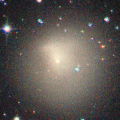
|
Now it is 11.5 mag (Mar. 23, Toshiyuki Takahashi). It will be getting lower gradually after this, and it will be unobservable in July in the Northern Hemisphere, or in August in the Southern Hemisphere.
Date(TT) R.A. (2000) Decl. Delta r Elong. m1 Best Time(A, h)
Apr. 12 9 36.25 10 50.1 5.700 6.272 120 13.8 20:13 (180, 44)
Apr. 19 9 35.82 10 51.2 5.800 6.273 113 13.8 19:46 (180, 44)
|

|
Now it is 13.7 mag (Apr. 4, Masayoshi Yoshimi). It stays 14 mag for a while. It stays observable in good condition.
Date(TT) R.A. (2000) Decl. Delta r Elong. m1 Best Time(A, h)
Apr. 12 15 30.75 -10 26.6 4.371 5.248 148 13.9 2:11 (180, 66)
Apr. 19 15 28.52 -9 28.4 4.337 5.265 155 13.9 1:41 (180, 65)
|

|
It brightens up to 13 mag in early summer. But the condition in this apparition is bad. Now it is 14.4 mag (Apr. 1, Hidetaka Sato). It stays 14 mag for a while. In the Northern Hemisphere, it is not observable now, but it will appear in July. It stays extremely low in the Southern Hemisphere. But it will become high in autumn.
Date(TT) R.A. (2000) Decl. Delta r Elong. m1 Best Time(A, h)
Apr. 12 23 44.93 -5 51.3 2.142 1.343 28 14.1 4:57 (270, 10)
Apr. 19 0 9.78 -3 52.0 2.102 1.310 28 13.9 5:02 (267, 10)
|

|
Now it is 13.7 mag (Mar. 30, Taras Prystavski). It will fade out rapidly after this. It will be unobservable in July.
Date(TT) R.A. (2000) Decl. Delta r Elong. m1 Best Time(A, h)
Apr. 12 4 16.93 15 17.1 1.983 1.432 43 14.2 19:03 (119, 13)
Apr. 19 4 39.50 17 18.8 2.011 1.435 42 14.2 18:55 (121, 12)
|
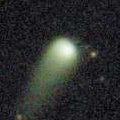
|
Now it is 14.2 mag (Mar. 28, Thomas Lehmann). It stays 15 mag for a while. It locates somewhat low in the Northern Hemisphere. But it will become high in summer. In the Southern Hemisphere, it is not observable now.
Date(TT) R.A. (2000) Decl. Delta r Elong. m1 Best Time(A, h)
Apr. 12 1 38.21 47 54.8 4.838 4.114 39 14.3 19:03 (129,-33)
Apr. 19 1 40.89 48 0.1 4.900 4.142 36 14.4 5:02 (231,-33)
|
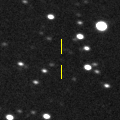
|
It stays 15 mag for a while. In the Northern Hemisphere, it is not observable now, but it will appear in June. It locates somewhat low in the Southern Hemisphere. But it will become high in summer.
Date(TT) R.A. (2000) Decl. Delta r Elong. m1 Best Time(A, h)
Apr. 12 23 54.99 -8 3.5 2.871 2.032 27 14.4 4:57 (273, 9)
Apr. 19 0 10.48 -6 44.6 2.849 2.041 29 14.4 5:02 (270, 12)
|

|
It is expected to brighten up to 13 mag in autumn, and it will be observable in good condition. Now it is 14.9 mag (Feb. 4, Alfons Diepvens). It stays 14 mag for a while. Now it is not observable. It will appear in May.
Date(TT) R.A. (2000) Decl. Delta r Elong. m1 Best Time(A, h)
Apr. 12 0 54.24 9 42.8 4.941 3.947 6 14.4 4:57 (267,-13)
Apr. 19 1 3.04 10 41.0 4.914 3.933 10 14.4 5:02 (263, -9)
|

|
Now it is 14.9 mag (Mar. 22, Hiroshi Abe). It stays 15 mag for a while. It will be getting lower gradually after this, and it will be unobservable in June.
Date(TT) R.A. (2000) Decl. Delta r Elong. m1 Best Time(A, h)
Apr. 12 6 28.43 14 12.0 5.761 5.590 75 14.8 19:03 (145, 33)
Apr. 19 6 32.29 14 43.1 5.855 5.580 69 14.8 18:55 (142, 31)
|

|
Parent asteroid of Geminids meteor shower. Now it is 15.9 mag (Jan. 12, E. Prosperi, M. Jaeger). It will fade out rapidly after this. It will be fainter than 18 mag in June. Now it is not observable. It will appear in May in the Northern Hemisphere, or in June in the Southern Hemisphere.
Date(TT) R.A. (2000) Decl. Delta r Elong. m1 Best Time(A, h)
Apr. 12 0 31.78 12 4.3 1.464 0.533 12 14.9 4:57 (262,-10)
Apr. 19 0 53.25 15 45.7 1.625 0.694 13 15.6 5:02 (257,-10)
|

|
Brightened rapidly. Now it is 14.6 mag (Jan. 31, Thomas Lehmann). Fading slowly. In the Northern Hemisphere, it will be unobservable soon. In the Southern Hemisphere, it is not observable now, but it will appear in May.
Date(TT) R.A. (2000) Decl. Delta r Elong. m1 Best Time(A, h)
Apr. 12 0 15.29 18 19.4 2.755 1.835 18 15.0 4:57 (254,-10)
Apr. 19 0 29.98 17 19.0 2.765 1.851 19 15.1 5:02 (253, -6)
|

|
Now it is 15.1 mag (Mar. 23, Andrew Pearce). Fading slowly. In the Northern Hemisphere, it will be getting lower gradually after this, and it will be unobservable in July. But it will be observable again in April. In the Southern Hemisphere, it stays observable in good condition.
Date(TT) R.A. (2000) Decl. Delta r Elong. m1 Best Time(A, h)
Apr. 12 12 48.07 -23 16.1 2.474 3.446 163 15.0 23:23 (180, 78)
Apr. 19 12 29.60 -20 57.0 2.497 3.453 158 15.1 22:37 (180, 76)
|

|
Now it is 14.8 mag (Mar. 23, Toshiyuki Takahashi). Fading slowly. In the Northern Hemisphere, it will be getting lower gradually after this, and it will be unobservable in July. In the Southern Hemisphere, it stays observable in good condition.
Date(TT) R.A. (2000) Decl. Delta r Elong. m1 Best Time(A, h)
Apr. 12 8 40.97 15 46.8 2.169 2.635 106 15.1 19:19 (180, 39)
Apr. 19 8 45.81 15 13.0 2.259 2.640 100 15.2 18:56 (180, 40)
|

|
It brightened up to 12.7 mag in last summer (Aug. 7, Thomas Lehmann). Now it is 14.9 mag (Apr. 7, Masayoshi Yoshimi). It stays 16 mag for a while. In the Northern Hemisphere, it will be getting higher gradually. In the Southern Hemisphere, it will be unobservable in August.
Date(TT) R.A. (2000) Decl. Delta r Elong. m1 Best Time(A, h)
Apr. 12 22 38.00 19 30.2 3.541 2.861 40 15.1 4:57 (240, 8)
Apr. 19 22 46.23 21 51.2 3.532 2.903 44 15.2 5:02 (234, 10)
|
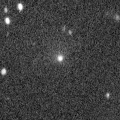
|
Very large comet. It is expected to brighten up to 13 mag in 2031. Now it is 15.3 mag (Apr. 4, ATLAS South Africa). It stays 15 mag for a while. In the Northern Hemisphere, it is not observable now. In the Northern Hemisphere, it is not observable until 2030.
Date(TT) R.A. (2000) Decl. Delta r Elong. m1 Best Time(A, h)
Apr. 12 3 55.28 -65 58.3 15.399 15.252 79 15.3 19:03 ( 30, 40)
Apr. 19 3 59.72 -65 46.9 15.359 15.228 80 15.3 18:55 ( 30, 39)
|

|
First return of a new periodic comet which brightened up to 15 mag in 2010. Now it is 14.3 mag (Mar. 29, Thomas Lehmann). It will fade out rapidly after this. It will be fainter than 18 mag in July. In the Northern Hemisphere, it will be getting lower gradually. It stays extremely low in the Southern Hemisphere.
Date(TT) R.A. (2000) Decl. Delta r Elong. m1 Best Time(A, h)
Apr. 12 6 0.98 35 57.4 1.741 1.664 68 15.4 19:03 (151, 12)
Apr. 19 6 25.37 36 0.3 1.800 1.684 67 15.5 18:55 (152, 12)
|

|
Now it is 15.2 mag (Mar. 23, Andrew Pearce). Fading slowly. It locates somewhat low in the Northern Hemisphere. In the Southern Hemisphere, it stays observable in good condition.
Date(TT) R.A. (2000) Decl. Delta r Elong. m1 Best Time(A, h)
Apr. 12 13 13.32 -33 51.8 2.685 3.616 154 15.4 23:50 (180, 89)
Apr. 19 13 11.08 -32 57.5 2.685 3.629 156 15.4 23:20 (180, 88)
|

|
Now it is 16.1 mag (Mar. 27, Thomas Lehmann). It stays 15 mag for a while. It will be unobservable in May.
Date(TT) R.A. (2000) Decl. Delta r Elong. m1 Best Time(A, h)
Apr. 12 3 51.12 18 54.2 3.298 2.579 37 15.5 19:03 (118, 6)
Apr. 19 4 3.98 19 18.5 3.335 2.563 33 15.5 18:55 (117, 4)
|
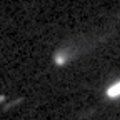
|
Now it is 16.5 mag (Mar. 26, Andrew Pearce). It stays 15 mag for a while. It locates somewhat low in the Northern Hemisphere. In the Southern Hemisphere, it stays observable in good condition.
Date(TT) R.A. (2000) Decl. Delta r Elong. m1 Best Time(A, h)
Apr. 12 18 47.36 -26 27.7 2.578 2.944 101 15.7 4:57 (219, 79)
Apr. 19 18 52.23 -26 46.0 2.483 2.940 107 15.7 5:02 (184, 82)
|

|
Now it is 15.6 mag (Mar. 21, Ken-ichi Kadota). It stays 16 mag for a while. In the Northern Hemisphere, it stays observable in good condition. In the Southern Hemisphere, it will never be observable after this.
Date(TT) R.A. (2000) Decl. Delta r Elong. m1 Best Time(A, h)
Apr. 12 11 6.85 65 3.5 4.038 4.362 102 15.9 21:43 (180,-10)
Apr. 19 10 57.81 65 30.0 4.112 4.354 97 15.9 21:07 (180,-10)
|

|
Now it is 16.1 mag (Mar. 31, Andrew Pearce). It stays 16 mag for a while. In the Northern Hemisphere, it will be unobservable in June. In the Southern Hemisphere, it stays observable in good condition.
Date(TT) R.A. (2000) Decl. Delta r Elong. m1 Best Time(A, h)
Apr. 12 11 27.37 -42 12.3 4.428 5.216 138 15.9 22:03 ( 0, 83)
Apr. 19 11 17.04 -40 39.3 4.456 5.222 135 15.9 21:26 ( 0, 84)
|

|
It is expected to brighten up to 13 mag in early summer in 2026. Now it is 16.8 mag (Jan. 30, Ken-ichi Kadota). Brightening slowly. In the Northern Hemisphere, it will be getting higher gradually. It locates somewhat low in the Southern Hemisphere. But it will become high in summer.
Date(TT) R.A. (2000) Decl. Delta r Elong. m1 Best Time(A, h)
Apr. 12 22 34.87 19 29.1 5.525 4.823 41 16.0 4:57 (239, 8)
Apr. 19 22 35.65 19 59.8 5.414 4.783 46 16.0 5:02 (233, 13)
|

|
It will brighten up to 13 mag in 2026. Now it is 16.3 mag (Apr. 9, ATLAS Chile). Brightening slowly. In the Southern Hemisphere, it stays observable in good condition.
Date(TT) R.A. (2000) Decl. Delta r Elong. m1 Best Time(A, h)
Apr. 12 19 47.86 -23 22.1 6.221 6.256 87 16.1 4:57 (246, 67)
Apr. 19 19 48.31 -22 53.6 6.062 6.214 94 16.0 5:02 (230, 72)
|

|
Now it is 15.8 mag (Mar. 24, Andrew Pearce). It stays 16 mag for a while. It will be getting lower gradually after this, and it will be unobservable in June. But it will be observable again in August in the Northern Hemisphere.
Date(TT) R.A. (2000) Decl. Delta r Elong. m1 Best Time(A, h)
Apr. 12 6 32.24 5 38.7 4.014 3.914 77 16.2 19:03 (141, 41)
Apr. 19 6 34.37 7 17.7 4.119 3.906 70 16.2 18:55 (137, 38)
|

|
It is expected to brighten up to 5 mag in 2026 January. Now it is 16.6 mag (Apr. 8, ATLAS-MLO, Mauna Loa). Brightening gradually. In the Northern Hemisphere, it stays observable in good condition. In the Southern Hemisphere, it will be unobservable in May. But it will be observable again in July.
Date(TT) R.A. (2000) Decl. Delta r Elong. m1 Best Time(A, h)
Apr. 12 18 27.77 50 55.1 4.110 4.258 91 16.4 4:57 (182, 4)
Apr. 19 18 26.71 52 8.3 4.003 4.181 93 16.2 4:38 (180, 3)
|

|
It brightened up to 13.8 mag in winter (Dec. 30, Thomas Lehmann). Now it is 16.4 mag (Apr. 3, D. Buczynski). Fading gradually. It will be fainter than 18 mag in July. In the Northern Hemisphere, it stays observable in good condition. It stays extremely low in the Southern Hemisphere.
Date(TT) R.A. (2000) Decl. Delta r Elong. m1 Best Time(A, h)
Apr. 12 8 25.69 52 12.1 2.705 2.932 92 16.3 19:04 (180, 3)
Apr. 19 8 34.45 50 1.9 2.810 2.967 88 16.4 18:55 (178, 5)
|

|
Now it is 16.1 mag (Mar. 22, Andrew Pearce). It stays 16 mag for a while. It will be unobservable in May in the Northern Hemisphere, or in July in the Southern Hemisphere. But it will be observable again in July in the Southern Hemisphere.
Date(TT) R.A. (2000) Decl. Delta r Elong. m1 Best Time(A, h)
Apr. 12 6 47.94 -17 58.7 6.644 6.629 84 16.3 19:03 (122, 62)
Apr. 19 6 50.90 -17 3.3 6.721 6.623 80 16.3 18:55 (118, 59)
|
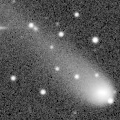
|
Now it is 16.1 mag (Mar. 23, ATLAS South Africa). It stays 17 mag for a while. In the Northern Hemisphere, it is not observable now. In the Southern Hemisphere, it will be getting lower gradually. But it will be getting higher again after June.
Date(TT) R.A. (2000) Decl. Delta r Elong. m1 Best Time(A, h)
Apr. 12 5 23.21 -39 58.7 7.387 7.174 73 16.5 19:03 ( 68, 54)
Apr. 19 5 24.24 -39 14.8 7.480 7.218 71 16.6 18:55 ( 69, 50)
|

|
It returned for the first time in 68 years. It brightened up to 6.2 mag in early last summer (July 1, Virgilio Gonano). Now it is 15.7 mag (Mar. 23, Toshiyuki Takahashi). Fading gradually. It will be fainter than 18 mag in June. It locates somewhat low in the Northern Hemisphere. In the Southern Hemisphere, it stays observable in good condition.
Date(TT) R.A. (2000) Decl. Delta r Elong. m1 Best Time(A, h)
Apr. 12 18 46.95 -22 50.7 3.449 3.774 101 16.5 4:57 (210, 76)
Apr. 19 18 46.21 -23 25.5 3.406 3.841 108 16.7 4:59 (180, 78)
|
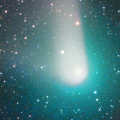
|
It brightened up to 8 mag from 2022 summer to 2023 spring. Now it is 15.4 mag (Mar. 27, Thomas Lehmann). It stays 17 mag for a while. It will be unobservable in May. But it will be observable again in July.
Date(TT) R.A. (2000) Decl. Delta r Elong. m1 Best Time(A, h)
Apr. 12 5 26.34 24 13.0 8.853 8.403 60 16.7 19:03 (138, 17)
Apr. 19 5 28.26 24 24.2 9.007 8.455 53 16.7 18:55 (135, 14)
|
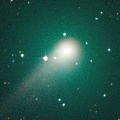
|
It was observed at 9-10 mag for a long time in 2023. Now it is 16.2 mag (Apr. 5, ATLAS South Africa). It stays 17 mag for a while. In the Northern Hemisphere, it will never be observable after this. In the Southern Hemisphere, it stays observable in good condition.
Date(TT) R.A. (2000) Decl. Delta r Elong. m1 Best Time(A, h)
Apr. 12 22 14.89 -62 38.1 7.257 7.145 79 16.8 4:57 (326, 44)
Apr. 19 22 17.26 -63 18.1 7.225 7.198 84 16.9 5:02 (328, 48)
|
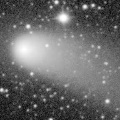
|
It brightened up to 9.6 mag from February to March in 2024 (Feb. 25, 2024, Thomas Lehmann). Now it is 16.7 mag (Mar. 22, Ken-ichi Kadota). It stays 17 mag for a while. In the Northern Hemisphere, it will be getting higher gradually. In the Southern Hemisphere, it is not observable now, but it will appear in May.
Date(TT) R.A. (2000) Decl. Delta r Elong. m1 Best Time(A, h)
Apr. 12 23 8.98 35 26.8 5.914 5.192 40 16.9 4:57 (232, -8)
Apr. 19 23 14.49 36 6.4 5.952 5.256 42 16.9 5:02 (228, -4)
|
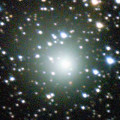
|
It brightened up to 8.3 mag in 2021-2022 winter (Jan. 6, 2022, Toshiyuki Takahashi). Now it is 18.8 mag (Mar. 26, ATLAS Chile). It stays 17 mag for a while. In the Northern Hemisphere, it will never be observable after this. In the Southern Hemisphere, it stays observable in good condition.
Date(TT) R.A. (2000) Decl. Delta r Elong. m1 Best Time(A, h)
Apr. 12 12 4.87 -59 50.6 9.368 9.999 126 16.9 22:41 ( 0, 65)
Apr. 19 12 1.42 -59 32.1 9.398 10.043 127 17.0 22:10 ( 0, 65)
|

|
It brightened up to 15.2 mag in winter (Dec. 30, ATLAS-MLO, Mauna Loa). Now it is 16.6 mag (Mar. 14, Ken-ichi Kadota). Fading gradually. It will be fainter than 18 mag in June. It will be getting lower gradually.
Date(TT) R.A. (2000) Decl. Delta r Elong. m1 Best Time(A, h)
Apr. 12 6 35.56 12 37.2 3.967 3.868 77 17.0 19:03 (146, 36)
Apr. 19 6 41.78 12 45.5 4.085 3.891 71 17.1 18:55 (143, 34)
|

|
Now it is 17.2 mag (Apr. 7, E. Cortes, B. Lutkenhoner). Brightening slowly. It locates somewhat low in the Northern Hemisphere. But it will become high in summer. In the Southern Hemisphere, it stays observable in good condition.
Date(TT) R.A. (2000) Decl. Delta r Elong. m1 Best Time(A, h)
Apr. 12 22 5.82 -20 37.8 3.466 3.026 56 17.1 4:57 (270, 38)
Apr. 19 22 15.21 -19 46.3 3.375 3.012 60 17.0 5:02 (265, 42)
|
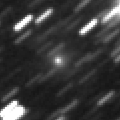
|
Very far object. Now it is 16.9 mag (Dec. 20, ATLAS Chile). It stays 17 mag for a while. In the Northern Hemisphere, it is not observable now. In the Southern Hemisphere, it will be getting higher gradually.
Date(TT) R.A. (2000) Decl. Delta r Elong. m1 Best Time(A, h)
Apr. 12 1 10.85 -53 58.2 11.095 10.671 62 17.0 4:57 (322, 21)
Apr. 19 1 13.68 -53 41.6 11.063 10.680 65 17.0 5:02 (320, 24)
|
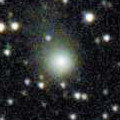
|
It brightened up to 12.1 mag in 2023 spring (May 20, 2023, Jose Guilherme de S. Aguiar). Now it is 17.4 mag (Mar. 25, ATLAS South Africa). It stays 17 mag for a while. In the Northern Hemisphere, it will be unobservable in May. In the Southern Hemisphere, it will be getting lower gradually. But it will be getting higher again after June.
Date(TT) R.A. (2000) Decl. Delta r Elong. m1 Best Time(A, h)
Apr. 12 5 38.48 -23 46.2 7.199 6.931 70 17.0 19:03 ( 96, 52)
Apr. 19 5 40.84 -22 50.3 7.319 6.979 66 17.1 18:55 ( 94, 48)
|

|
It approached to Earth down to 0.3 a.u. in March. Now it is 16.8 mag (Mar. 27, ATLAS-MLO, Mauna Loa). It will fade out rapidly after this. It will be fainter than 18 mag in May. In the Northern Hemisphere, it stays observable in good condition. In the Southern Hemisphere, it will never be observable after this.
Date(TT) R.A. (2000) Decl. Delta r Elong. m1 Best Time(A, h)
Apr. 12 9 39.44 75 51.3 0.428 1.087 89 17.0 20:28 (180,-21)
Apr. 19 11 36.17 72 7.2 0.473 1.140 94 17.4 21:52 (180,-17)
|

|
It brightened up to 13.1 mag in autumn (Nov. 1, Thomas Lehmann). Now it is 16.4 mag (Apr. 2, D. Buczynski). Fading gradually. It will be fainter than 18 mag in June. It stays observable in good condition.
Date(TT) R.A. (2000) Decl. Delta r Elong. m1 Best Time(A, h)
Apr. 12 17 58.70 13 15.0 2.394 2.864 107 17.0 4:38 (180, 42)
Apr. 19 17 52.94 12 53.3 2.367 2.930 114 17.1 4:05 (180, 42)
|

|
Now it is 17.0 mag (Apr. 7, ATLAS Chile). It stays 17 mag for a while. In the Northern Hemisphere, it will be unobservable in July. In the Southern Hemisphere, it stays observable in good condition.
Date(TT) R.A. (2000) Decl. Delta r Elong. m1 Best Time(A, h)
Apr. 12 11 31.43 -39 12.9 4.555 5.368 140 17.1 22:08 ( 0, 86)
Apr. 19 11 24.93 -37 23.3 4.569 5.364 138 17.1 21:34 ( 0, 88)
|

|
It returns for the first time in 70 years. It brightened up to 3.7 mag in early April in 2024 (Apr. 6, 2024, Jose Guilherme Aguiar). Now it is 17.9 mag (Mar. 14, ATLAS Chile). Fading slowly. It will be fainter than 18 mag in June. It stays extremely low in the Northern Hemisphere. In the Southern Hemisphere, it stays observable in good condition.
Date(TT) R.A. (2000) Decl. Delta r Elong. m1 Best Time(A, h)
Apr. 12 17 2.01 -51 40.4 4.120 4.673 117 17.1 3:43 ( 0, 73)
Apr. 19 16 55.31 -51 43.3 4.098 4.738 124 17.2 3:09 ( 0, 73)
|

|
Now it is 17.3 mag (Mar. 30, ATLAS South Africa). It stays 17 mag for a while. It will be getting lower gradually after this, and it will be unobservable in May in the Northern Hemisphere, or in July in the Southern Hemisphere. But it will be observable again in August in the Southern Hemisphere.
Date(TT) R.A. (2000) Decl. Delta r Elong. m1 Best Time(A, h)
Apr. 12 6 32.65 -5 59.1 4.554 4.472 78 17.2 19:03 (131, 51)
Apr. 19 6 36.97 -5 44.8 4.639 4.468 74 17.2 18:55 (127, 48)
|

|
It will brighten up to 9 mag in 2026 spring. Now it is 17.3 mag (Mar. 22, ATLAS-MLO, Mauna Loa). Brightening slowly. It stays observable in good condition.
Date(TT) R.A. (2000) Decl. Delta r Elong. m1 Best Time(A, h)
Apr. 12 10 22.13 15 56.5 2.485 3.215 129 17.3 20:59 (180, 39)
Apr. 19 10 19.36 15 59.9 2.531 3.178 121 17.3 20:29 (180, 39)
|

|
Now it is 17.2 mag (Mar. 31, ATLAS South Africa). It stays 18 mag for a while. In the Northern Hemisphere, it will be unobservable in May. In the Southern Hemisphere, it stays observable in good condition.
Date(TT) R.A. (2000) Decl. Delta r Elong. m1 Best Time(A, h)
Apr. 12 7 25.59 -41 10.5 3.505 3.752 96 17.3 19:03 ( 59, 77)
Apr. 19 7 26.83 -38 5.3 3.553 3.740 92 17.3 18:55 ( 74, 74)
|

|
Peculiar asteroid moving along a cometary orbit. Now it is 17.5 mag (Feb. 24, Taras Prystavski). It stays 17 mag for a while. In the Northern Hemisphere, it will be unobservable in June. It locates somewhat low in the Southern Hemisphere.
Date(TT) R.A. (2000) Decl. Delta r Elong. m1 Best Time(A, h)
Apr. 12 5 10.15 -1 45.9 2.282 1.946 57 17.4 19:03 (115, 34)
Apr. 19 5 25.65 -0 45.1 2.299 1.919 55 17.4 18:55 (115, 32)
|

|
Now it is 17.4 mag (Sept. 20, Taras Prystavski). It stays 17 mag for a while. In the Northern Hemisphere, it will be getting higher gradually. In the Southern Hemisphere, it stays observable in good condition.
Date(TT) R.A. (2000) Decl. Delta r Elong. m1 Best Time(A, h)
Apr. 12 21 13.98 -2 14.3 3.514 3.180 62 17.4 4:57 (241, 37)
Apr. 19 21 21.11 -1 25.9 3.445 3.195 67 17.4 5:02 (235, 41)
|

|
Now it is 17.3 mag (Oct. 31, ATLAS Chile). It stays 17 mag for a while. In the Northern Hemisphere, it is not observable now, but it will be observable soon. In the Southern Hemisphere, it will be getting higher gradually.
Date(TT) R.A. (2000) Decl. Delta r Elong. m1 Best Time(A, h)
Apr. 12 23 14.83 -7 53.0 4.056 3.292 35 17.6 4:57 (267, 17)
Apr. 19 23 23.90 -7 4.1 3.999 3.294 40 17.5 5:02 (263, 22)
|
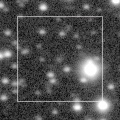
|
Now it is 17.4 mag (Apr. 1, ATLAS Chile). It stays 18 mag for a while. It stays observable in good condition.
Date(TT) R.A. (2000) Decl. Delta r Elong. m1 Best Time(A, h)
Apr. 12 17 13.12 -25 25.7 6.181 6.773 122 17.8 3:53 (180, 80)
Apr. 19 17 9.16 -24 52.3 6.064 6.758 130 17.7 3:22 (180, 80)
|

|
Now it is 17.8 mag (Mar. 27, Alfons Diepvens). It stays 18 mag for a while. In the Northern Hemisphere, it stays observable in good condition. In the Southern Hemisphere, it will never be observable after this.
Date(TT) R.A. (2000) Decl. Delta r Elong. m1 Best Time(A, h)
Apr. 12 7 39.73 59 46.7 5.437 5.441 84 17.7 19:03 (174, -5)
Apr. 19 7 44.43 58 31.2 5.527 5.447 80 17.8 18:55 (172, -4)
|
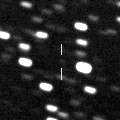
|
Now it is 17.3 mag (Mar. 6, ATLAS Chile). It stays 18 mag for a while. In the Northern Hemisphere, it will never be observable after this.
Date(TT) R.A. (2000) Decl. Delta r Elong. m1 Best Time(A, h)
Apr. 12 2 59.03 -48 20.3 5.577 5.164 60 17.7 19:03 ( 50, 30)
Apr. 19 3 1.28 -48 0.2 5.585 5.179 61 17.7 18:55 ( 49, 28)
|

|
Now it is 17.8 mag (Mar. 27, ATLAS-MLO, Mauna Loa). It stays 18 mag for a while. In the Northern Hemisphere, it stays observable in good condition. In the Southern Hemisphere, it is not observable now, but it will appear in August.
Date(TT) R.A. (2000) Decl. Delta r Elong. m1 Best Time(A, h)
Apr. 12 19 23.86 56 45.5 5.175 5.141 82 17.8 4:57 (189, -3)
Apr. 19 19 16.89 58 5.6 5.130 5.134 84 17.8 5:02 (183, -3)
|

|
Now it is 17.8 mag (Mar. 17, ATLAS Chile). It stays 18 mag for a while. In the Northern Hemisphere, it will be unobservable in May. It locates somewhat low in the Southern Hemisphere. But it will become high in autumn.
Date(TT) R.A. (2000) Decl. Delta r Elong. m1 Best Time(A, h)
Apr. 12 4 38.06 -5 52.5 4.556 4.003 51 17.8 19:03 (105, 30)
Apr. 19 4 45.47 -5 16.9 4.621 4.007 47 17.8 18:55 (104, 27)
|

|
Now it is 17.2 mag (Mar. 29, ATLAS South Africa). Fading slowly. It will be fainter than 18 mag soon. It stays extremely low in the Northern Hemisphere. In the Southern Hemisphere, it will be getting lower gradually.
Date(TT) R.A. (2000) Decl. Delta r Elong. m1 Best Time(A, h)
Apr. 12 6 8.66 -24 10.7 4.851 4.732 77 17.8 19:03 (101, 58)
Apr. 19 6 8.93 -22 57.2 4.989 4.784 72 17.9 18:55 ( 99, 54)
|

|
Now it is 17.5 mag (Mar. 29, ATLAS-MLO, Mauna Loa). Fading gradually. It will be fainter than 18 mag soon. In the Northern Hemisphere, it will be getting lower gradually.
Date(TT) R.A. (2000) Decl. Delta r Elong. m1 Best Time(A, h)
Apr. 12 8 6.38 28 14.9 1.995 2.320 95 17.9 19:03 (175, 27)
Apr. 19 8 10.51 25 9.2 2.088 2.325 90 18.0 18:55 (171, 30)
|

|
Now it is 18.8 mag (Apr. 3, ATLAS-HKO, Haleakala). It stays 18 mag for a while. It stays observable in good condition.
Date(TT) R.A. (2000) Decl. Delta r Elong. m1 Best Time(A, h)
Apr. 12 17 7.14 14 36.2 5.004 5.565 119 18.0 3:47 (180, 40)
Apr. 19 17 7.04 15 11.0 4.916 5.541 123 17.9 3:19 (180, 40)
|
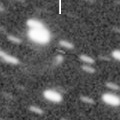
|
Now it is 17.8 mag (Apr. 7, W. Hasubick). It stays 18 mag for a while. It stays observable in good condition.
Date(TT) R.A. (2000) Decl. Delta r Elong. m1 Best Time(A, h)
Apr. 12 19 42.19 15 3.8 5.275 5.245 82 17.9 4:57 (206, 36)
Apr. 19 19 39.70 15 19.4 5.201 5.278 88 17.9 5:02 (195, 38)
|

|
It approached to Sun down to 0.11 a.u. on Mar. 9. It will fade out rapidly after this. It stays observable in good condition.
Date(TT) R.A. (2000) Decl. Delta r Elong. m1 Best Time(A, h)
Apr. 12 6 30.24 6 40.2 0.291 0.976 76 18.2 19:03 (143, 41)
Apr. 19 8 14.83 6 50.1 0.392 1.112 95 18.4 18:55 (170, 48)
|
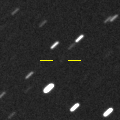
|
It became much fainter than predicted after the perihelion passage. Now it is 20.0 mag (Mar. 12, Taras Prystavski). It stays 20 mag for a while. It stays observable in good condition.
Date(TT) R.A. (2000) Decl. Delta r Elong. m1 Best Time(A, h)
Apr. 12 19 50.28 -11 13.5 1.985 2.139 84 19.5 4:57 (227, 58)
Apr. 19 19 59.98 -10 16.6 1.925 2.154 88 19.5 5:02 (217, 61)
|
|
![]()
 C/2024 G3 ( ATLAS )
C/2024 G3 ( ATLAS ) C/2023 A3 ( Tsuchinshan-ATLAS )
C/2023 A3 ( Tsuchinshan-ATLAS ) 29P/Schwassmann-Wachmann 1
29P/Schwassmann-Wachmann 1 C/2021 G2 ( ATLAS )
C/2021 G2 ( ATLAS ) 217P/LINEAR
217P/LINEAR 49P/Arend-Rigaux
49P/Arend-Rigaux C/2022 E2 ( ATLAS )
C/2022 E2 ( ATLAS ) 48P/Johnson
48P/Johnson C/2022 N2 ( PanSTARRS )
C/2022 N2 ( PanSTARRS ) C/2022 QE78 ( ATLAS )
C/2022 QE78 ( ATLAS ) (3200) Phaethon
(3200) Phaethon C/2024 J2 ( Wierzchos )
C/2024 J2 ( Wierzchos ) C/2024 L5 ( ATLAS )
C/2024 L5 ( ATLAS ) P/2023 S1 ( PanSTARRS )
P/2023 S1 ( PanSTARRS ) C/2023 C2 ( ATLAS )
C/2023 C2 ( ATLAS ) C/2014 UN271 ( Bernardinelli-Bernstein )
C/2014 UN271 ( Bernardinelli-Bernstein ) 496P/2024 S3 ( Hill )
496P/2024 S3 ( Hill ) C/2023 T3 ( Fuls )
C/2023 T3 ( Fuls ) 43P/Wolf-Harrington
43P/Wolf-Harrington 65P/Gunn
65P/Gunn C/2023 H5 ( Lemmon )
C/2023 H5 ( Lemmon ) C/2023 F3 ( ATLAS )
C/2023 F3 ( ATLAS ) C/2023 R1 ( PanSTARRS )
C/2023 R1 ( PanSTARRS ) C/2024 J3 ( ATLAS )
C/2024 J3 ( ATLAS ) C/2024 A1 ( ATLAS )
C/2024 A1 ( ATLAS ) C/2024 E1 ( Wierzchos )
C/2024 E1 ( Wierzchos ) C/2023 Q1 ( PanSTARRS )
C/2023 Q1 ( PanSTARRS ) C/2022 R6 ( PanSTARRS )
C/2022 R6 ( PanSTARRS ) C/2019 U5 ( PanSTARRS )
C/2019 U5 ( PanSTARRS ) 13P/Olbers
13P/Olbers C/2017 K2 ( PanSTARRS )
C/2017 K2 ( PanSTARRS ) C/2020 V2 ( ZTF )
C/2020 V2 ( ZTF ) C/2021 S3 ( PanSTARRS )
C/2021 S3 ( PanSTARRS ) C/2019 L3 ( ATLAS )
C/2019 L3 ( ATLAS ) 472P/2023 RL75 ( NEAT-LINEAR )
472P/2023 RL75 ( NEAT-LINEAR ) 47P/Ashbrook-Jackson
47P/Ashbrook-Jackson C/2019 E3 ( ATLAS )
C/2019 E3 ( ATLAS ) C/2020 K1 ( PanSTARRS )
C/2020 K1 ( PanSTARRS ) 499P/2025 A5 ( Catalina )
499P/2025 A5 ( Catalina ) C/2024 B1 ( Lemmon )
C/2024 B1 ( Lemmon ) C/2024 G2 ( ATLAS )
C/2024 G2 ( ATLAS ) 12P/Pons-Brooks
12P/Pons-Brooks 195P/Hill
195P/Hill 88P/Howell
88P/Howell C/2024 X2 ( ATLAS )
C/2024 X2 ( ATLAS ) (308607) 2005 WY3
(308607) 2005 WY3 362P/(457175) 2008 GO98
362P/(457175) 2008 GO98 302P/Lemmon-PanSTARRS
302P/Lemmon-PanSTARRS C/2024 G6 ( ATLAS )
C/2024 G6 ( ATLAS ) C/2024 N4 ( Sarneczky )
C/2024 N4 ( Sarneczky ) C/2023 U1 ( Fuls )
C/2023 U1 ( Fuls ) C/2023 V1 ( Lemmon )
C/2023 V1 ( Lemmon ) 242P/Spahr
242P/Spahr C/2022 L2 ( ATLAS )
C/2022 L2 ( ATLAS ) C/2024 V1 ( Borisov )
C/2024 V1 ( Borisov ) C/2024 G4 ( PanSTARRS )
C/2024 G4 ( PanSTARRS ) C/2022 U1 ( Leonard )
C/2022 U1 ( Leonard ) (431760) 2008 HE
(431760) 2008 HE 105P/Singer Brewster
105P/Singer Brewster![]()

























































